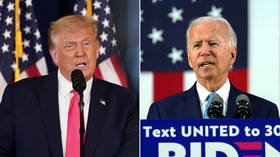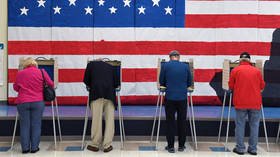Forget the deficit in the polls, Trump can still win the election – and here’s how he might just do it

While still trailing Joe Biden, President Trump is closing the gap as the race for the White House tightens. What’s clear is that how the pandemic plays out over the next few months is going to be key to deciding the election.
If the prevailing media narrative is to be believed, President Trump’s handling – or mishandling – of the pandemic has sent his re-election plans into a death spiral. The president can’t hold rallies, hasn’t been able to find a coherent and effective line of attack against Joe Biden, and early voting starts soon.
But a broad look at all the metrics suggests that the race has actually begun to tighten a little, and things are far from over.
Biden’s national lead in the polls was at 9.6 percent in early July. It has now receded somewhat, to 8.3 percent. Things have also turned around in the money stakes. The president’s campaign and the Republican National Committee reported raising $165 million in July, compared with $140 million for Joe Biden’s campaign and the Democratic National Committee, breaking a two-month straight lead Biden had taken. The RNC stated that the monthly total eclipsed any single month in all of 2016.
Polling data is suggesting that the gap is narrowing in the swing states. After trailing in Georgia throughout the year, Biden developed a slight lead in mid-July, peaking at 1.8 percent. This lead has now ebbed away, returning to a fractional Trump lead of a point or so. Similarly, having trailed Trump all year in Iowa, Biden nudged into a miniscule lead in late June; but by late July this had ebbed away, and Trump is now fractionally back in the lead in the average of the polls.
In usually conservative Missouri, Biden rose to within striking distance of Trump in mid-July, registering 45 percent to the president’s 47 percent. That has since expanded again to a six-point margin in Trump’s favor.
Also on rt.com In an era of fake news, can we trust the MSM polls that show Trump badly trailing Biden in the race for the US presidency?Through June and July, Biden established a 2.5 percent lead over Trump in Ohio, a state that had generally been considered Republican-trending. By late July, into August, the slim lead had faded into a virtual tie.
In Wisconsin, where Trump was leading for much of the year, Biden took a tiny lead in the spring, which expanded to almost 10 points in late June. It has since receded somewhat, in the last week or so, to a lead of 6.6 percent.
In Florida, Trump was trailing Biden by an average of 2.5 percent throughout April and May. When the second wave of the coronavirus swept through the state, the lead expanded to six or seven points, peaking at 7.6 percent in late July. While Trump still has a great deal of catch-up to do, the race has shown some early signs of tightening, with Biden’s lead now at 5.8 percent. This may seem like a significant deficit to make up, but considering Florida was, for a month or two, the global hotspot for the virus, and given there are three months ahead for the pandemic to feasibly abate and the local economy to show signs of recovery, the deficit is by no means insurmountable.
Trump’s approval rating is low, but this doesn’t necessarily mean he is destined for defeat. He had an eight-point lead in the betting averages as late as May, when his approval rating, as it has been for most of his presidency, was low, hovering in a very narrow band – around the 42-43 percent mark. This means the betting agencies felt Trump could win with such a low approval rating, presumably because he won in 2016 when his popularity was only slightly higher. This is partly due to the fact he has better odds of winning in the battleground states that decide the electoral college.
The media has been stating, over and over, that Trump’s poll numbers have dived, or are crashing, but a closer look reveals that, in the average of the polls, he only dipped down to about 40 percent for a month or so at the peak of the crisis, a couple of points lower than his average. In the last week, he has shown, for the first time, a very modest uptick of a point or so. Similarly, the divide in his approval/disapproval rating may have peaked a few weeks ago at 40 percent approval and 56 percent disapproval, and this is now tightening up slightly.
Also on rt.com The 2020 US election will be the most expensive ever, but the BILLIONS spent will barely affect the outcomeMany in the media have also pointed to polling about the direction of the country. The right track/wrong track metric is indeed dire – 69 percent saying the country is on the wrong track, to 24 percent saying it is on the right track; but these numbers are no worse than at many times during Barack Obama’s presidency.
In late July 2016, almost as many months out from the election of that year, the ‘wrong-direction’ number was 69 percent, with only 23 percent feeling the country was on the right track. In December of 2015, it was 65 percent to 25 percent. In October 2011, it was 76 percent to 17 percent, and in October 2013 it was 75 percent to 17 percent.
Voters, albeit by a small margin, still rate President Trump higher on who is best to manage the economy. This is a figure that may suggest they have distinguished the present crisis – including the worst unemployment and GDP numbers in generations, if not in history – from the president’s previous performance with the economy, and a majority, therefore, are not blaming him for the economic malaise. Or that while disappointed or aggravated by his flawed response to the crisis, they still consider him inherently better when it comes to economic leadership.
Another factor: about half of Americans have some kind of share or investment portfolio, and Wall Street has been fairly resilient, so those people’s returns have either been holding steady, or improving.
Trump’s fortunes, then, hinge on public perceptions about the pandemic. By late October, Americans might still consider themselves in the midst of a public health crisis. Then again, the general perception might be that America is emerging from, or has largely emerged from the crisis.
Also on rt.com Is it in the bag, Joe? 5 times the Democrats blew a winnable electionThis is the great unknown of the campaign. In the aftermath of Covid-19, Americans may have had enough of government restrictions, government cheques, federal mandates and officialdom, and may not be so keen for the types of liberal government programs and regulations offered by Joe Biden. Instead, they might be hankering for laissez faire freedoms, and have an attitude to cut loose. American voters’ ideal of 2021 might be a return to 2019.
Looking at all this, we can see the broad contours of how Trump might feasibly still win the election. Firstly, in this best-case scenario, the second wave of the pandemic recedes, the number of cases declines, and a few weeks later, the mortality rate also begins to recede.
The figures will still be high, and some regions of the country will see flare-ups; but there may be a sense of the worst being over, and a gradual resumption of normality. Those who dislike Trump personally, and even disapproved of much of his handling of the pandemic, but are ultimately inclined towards him for economic reasons; those motivated by core principles and social issues and see Trump as a means to secure an expanded majority on the Supreme Court; and those wary about cultural elites, political correctness and cancel culture, could drift reluctantly back. His approval rating might rise a couple of percentage points, to the 42-43 percent it was in March.
At this point, states the Democrats had been feeling optimistic about drift into a range where it may not be worth the expense of campaigning. Georgia, Ohio and possibly Texas, while still in the margin of error, begin to slightly favor Trump again. The battleground becomes concentrated around the same number of states as in March: Pennsylvania, Michigan, Wisconsin, North Carolina, Florida and perhaps Arizona. Some of these states drift into the margin of error.
Trump still has to win most of them. But all of a sudden, no one is sure he can’t.
Like this story? Share it with a friend!
The statements, views and opinions expressed in this column are solely those of the author and do not necessarily represent those of RT.














